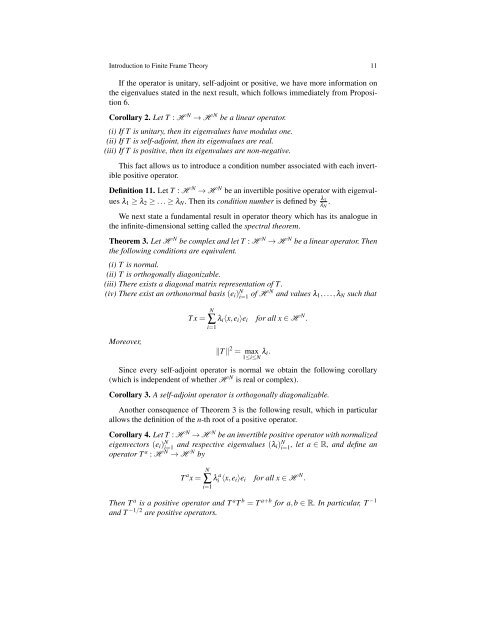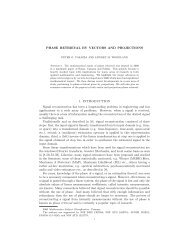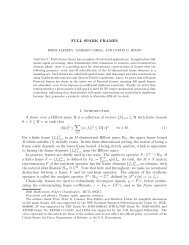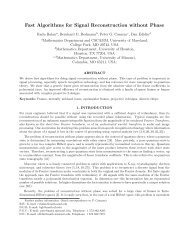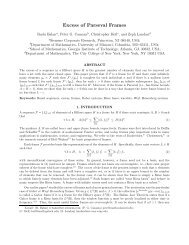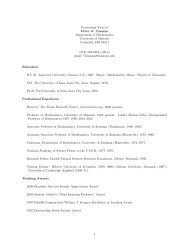Introduction to Finite Frame Theory - Frame Research Center
Introduction to Finite Frame Theory - Frame Research Center
Introduction to Finite Frame Theory - Frame Research Center
Create successful ePaper yourself
Turn your PDF publications into a flip-book with our unique Google optimized e-Paper software.
<strong>Introduction</strong> <strong>to</strong> <strong>Finite</strong> <strong>Frame</strong> <strong>Theory</strong> 11<br />
If the opera<strong>to</strong>r is unitary, self-adjoint or positive, we have more information on<br />
the eigenvalues stated in the next result, which follows immediately from Proposition<br />
6.<br />
Corollary 2. Let T : H N → H N be a linear opera<strong>to</strong>r.<br />
(i) If T is unitary, then its eigenvalues have modulus one.<br />
(ii) If T is self-adjoint, then its eigenvalues are real.<br />
(iii) If T is positive, then its eigenvalues are non-negative.<br />
This fact allows us <strong>to</strong> introduce a condition number associated with each invertible<br />
positive opera<strong>to</strong>r.<br />
Definition 11. Let T : H N → H N be an invertible positive opera<strong>to</strong>r with eigenvalues<br />
λ 1 ≥ λ 2 ≥ ... ≥ λ N . Then its condition number is defined by λ 1<br />
λ N<br />
.<br />
We next state a fundamental result in opera<strong>to</strong>r theory which has its analogue in<br />
the infinite-dimensional setting called the spectral theorem.<br />
Theorem 3. Let H N be complex and let T : H N → H N be a linear opera<strong>to</strong>r. Then<br />
the following conditions are equivalent.<br />
(i) T is normal.<br />
(ii) T is orthogonally diagonizable.<br />
(iii) There exists a diagonal matrix representation of T .<br />
(iv) There exist an orthonormal basis (e i ) N i=1 of H N and values λ 1 ,...,λ N such that<br />
Moreover,<br />
T x =<br />
N<br />
∑<br />
i=1<br />
λ i 〈x,e i 〉e i for all x ∈ H N .<br />
‖T ‖ 2 = max<br />
1≤i≤N λ i.<br />
Since every self-adjoint opera<strong>to</strong>r is normal we obtain the following corollary<br />
(which is independent of whether H N is real or complex).<br />
Corollary 3. A self-adjoint opera<strong>to</strong>r is orthogonally diagonalizable.<br />
Another consequence of Theorem 3 is the following result, which in particular<br />
allows the definition of the n-th root of a positive opera<strong>to</strong>r.<br />
Corollary 4. Let T : H N → H N be an invertible positive opera<strong>to</strong>r with normalized<br />
eigenvec<strong>to</strong>rs (e i ) N i=1 and respective eigenvalues (λ i) N i=1<br />
, let a ∈ R, and define an<br />
opera<strong>to</strong>r T a : H N → H N by<br />
T a x =<br />
N<br />
∑<br />
i=1<br />
λ a<br />
i 〈x,e i 〉e i for all x ∈ H N .<br />
Then T a is a positive opera<strong>to</strong>r and T a T b = T a+b for a,b ∈ R. In particular, T −1<br />
and T −1/2 are positive opera<strong>to</strong>rs.


